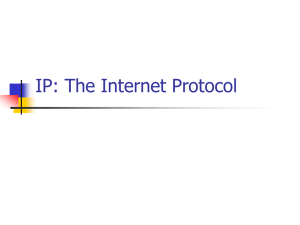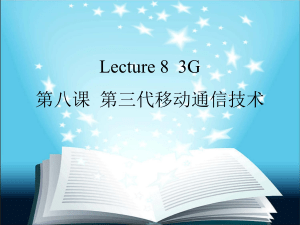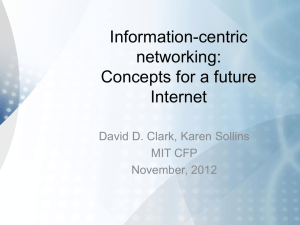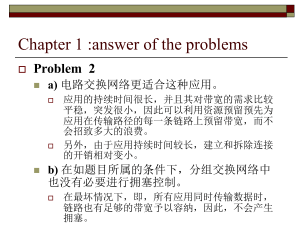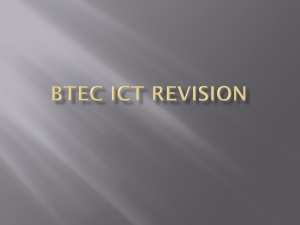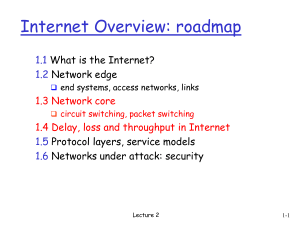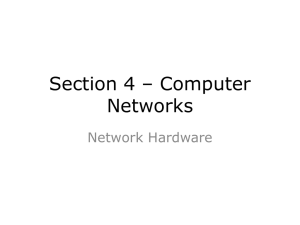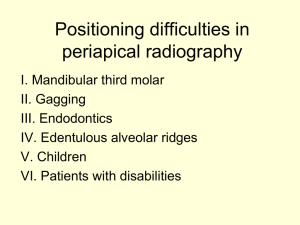Introduction - Massey University
advertisement
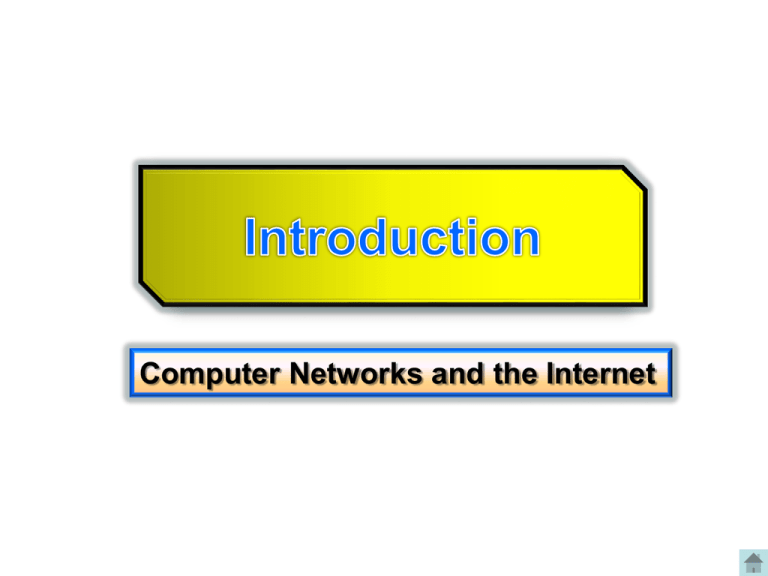
Computer Networks and the Internet Learning Outcomes 159.334 At the end of this session, the students should be able to: Explain what the Internet is all about Explain what is a protocol Describe what comprises the network edge Describe what comprises the network core Explain connection-oriented service Explain connectionless service Compare circuit-switched network against packet-switched network Answer the short exercises given in the session Introduction What’s the Internet? UNIX-based workstations laptop Digital cameras Automobile Email server Web-page server WebTV PDAs with wireless Internet connections toaster Household appliances HOSTS or END SYSTEMS What’s the Internet? Nuts and bolts of the Internet • Hardware components • Software Networking Infrastructure • provides services to distributed applications • infrastructure where new applications are being constantly invented and deployed What’s the Internet? “Nuts and Bolts” View global network of networks Interconnects hundreds of millions of computing devices provides: • Global communication • Storage • Computation infrastructure End-to-End System: End System “edge” Core End System “edge” SETI@HOME—MASSIVELY DISTRIBUTED COMPUTING FOR SETI What is SETI@home? SETI@home is a scientific experiment that uses Internet-connected computers in the Search for Extraterrestrial Intelligence (SETI). You can participate by running a free program that downloads and analyzes radio telescope data. http://setiathome.ssl.berkeley.edu/ The Network Structure • network edge: applications and hosts • network core: – routers – network of networks • access networks, physical media: communication links What’s the Internet? “Nuts and Bolts” View End-to-End System End System=HOST End System Core End System Access networks Physical media Where much internet architecture complexity is placed Communication links Communication Transport data links Switches Characterized of bandwidth Made up in of terms different types of physical media: Link transmission Coaxial cablerate Measured in bits/second Copper wire Fiber optics Radio Spectrum Connect end systems to the network core Where is the Network Core? ? NETWORK CORE Sender End System Router End System X End System Receiver End System path or route What’s in the Links? End System Router Internet uses packet switching to allow Takes a chunk of information arriving on one of for multiple communicating end systems its incoming communication links and forwards tothat share a path, or partson ofone a path, the chunk of information of its at outgoing same time communication links packet What’s a protocol? a human protocol and a computer network protocol: TCP connection request Hi Hi TCP connection reply Got the time? Get http://www.massey.ac.nz/ 2:00 <file> time What’s a protocol? Human Protocols: Network Protocols: • Something we execute all the time • Offer a greeting • Wait for a response • Analyze the response • Act accordingly • Similar to human protocol, except that entities are machines rather than humans • all communication activities in the Internet are governed by protocols In order for protocols to work, both entities must observe the same protocol. • There is a set of conventional actions taken when messages are sent and received. Networking – understanding the what, why and how of networking protocols What’s a protocol? A protocol defines: ofthat messages * Allformat activitiesand in theorder Internet involves 2 orsent moreand communicating entities are governed entities by a protocol. received among network and taken There areactions protocols in: on the transmission and/or receipt of a message, or other • Routers Protocols determine a packet’s path from source to event destination • NIC hardware-implemented protocols control the flow of Communicating Entities: the bits on the “wire” • End Systems Software components Hardware, congestion-control protocols control the rate at which packets are transmitted between sender and receiver Different protocols are used to accomplish different communication tasks: What’s the Internet? “nuts & bolts” view Protocols - control the sending and receiving of information within the Internet - run by End Systems, routers, etc.; TCP IP Two of the most important protocols in the Internet (principal protocols) TCP – Transmission Control Protocol IP – Internet Protocol – specifies the format of the packets that are sent and received among routers and end systems INTERNET STANDARDS Made possible through standards developed by (IETF) Internet Engineering Task Force RFCs (Request for Comments) define protocols such as TCP, IP, HTTP, SMTP What’s the Internet? A Service View • Provides a communication infrastructure that allows distributed applications running on its end systems to exchange data with each other. Remote login email Web surfing Instant messaging Internet telephony “the Web” – distributed application that use the communication services provided by the Internet • Communication services provided to distributed applications: Connection-Oriented Reliable Service Guarantees that data is delivered orderly and completely (sender to receiver) Connectionless Unreliable Service Delivery is not guaranteed Question Why would we opt for a connectionless unreliable service when there is a connection-oriented reliable service that is available? Hold on to that thought for a while… ? A closer look at the Network Edge What happens in the network edge? The sending End System doesn’t know how messages are actually sent. It only needs to know what services are provided, and so the “nuts and bolts” of the Internet serves as a “black box” that transfers messages between distributed communicating components. There is some level of abstraction that hides the nittygritty part of the communication process between two end Client/Server Model - Most prevalent structure for Internet applications; although not systems all applications are purely client, or purely of server type (e.g. P2P file sharing) A closer look at the Network Edge What happens in the network edge? End Systems (Hosts): • run application program • e.g., WWW, email • at “edge of network” Client/Server Model • client host requests, receives service from server • e.g. WWW client (browser)/server; email client/server Client/Server Model - Most prevalent structure for Internet applications; although not all applications are purely client, or purely of server type (e.g. P2P file sharing) The Network Edge “Connection” between two End Systems: (e.g. Web application or Internet phone application) – Nothing more than allocated buffers and state variables in the End-Systems Internet provides two type of services to End-System Applications: 1. Connection-oriented service – (TCP) App’s using TCP: HTTP (WWW), FTP (file transfer), Telnet (remote login), SMTP (email) 2. Connectionless service – (UDP) App’s using UDP: streaming media, teleconferencing, Internet telephony “Connection” Network edge: connection-oriented service performs handshaking * Goal: data transfer between Q end system. • handshaking: setup (prepare for) data transfer ahead of time – Hello, hello back human protocol – set up “state” in two communicating hosts Transmission Control Protocol (TCP) • Internet’s connection-oriented service TCP service [RFC 793] Provides: • Reliable data transfer: – loss: handled using acknowledgements and retransmissions • Flow Control: – Ensures that the sender won’t overwhelm receiver • Congestion Control: – Instructs senders to “slow down sending rate” when network is congested – Prevents gridlock Network Edge: TCP Service 3-way Handshake Control packet CONNECTION ESTABLISHED DATA acknowledgement request CLIENT * SERVER Reliable data transfer is achieved through acknowledgements and retransmissions Data is delivered without error and in proper order Network Edge: TCP Service Handshaking Procedure: Case: Retransmission of Request Control packet Client is packet waitingwas for Acknowledgement Client assumes lost, decides to retransmit DATA acknowledgement CLIENT * SERVER Reliable data transfer is achieved through acknowledgements and retransmissions Data is delivered without error and in proper order Network Edge: TCP Service Problem occurs when one communicating End-System transmits faster than the other End-System This End-System does not receive an acknowledgement yet, and so it issues another packet Control packet CLIENT CLIENT CLIENT CLIENT SERVER Flow control forces the sending End System not to send too many packets too fast for the receiver TCP/IP provides the Flow control service Network Edge: TCP Service Problem: Gridlock sets-in when there is packet loss due to router congestion CLIENT The sending system’s message is lost due to congestion, and is alerted when it stops receiving acknowledgements of packets sent SERVER Congestion control forces the End Systems to decrease the rate at which packets are sent during periods of congestion Network edge: connectionless service No handshaking procedure; End-Systems just simply send the packet Goal: data transfer between end systems – same as before! • UDP - User Datagram Protocol – [RFC 768]: Internet’s connectionless service – unreliable data transfer – no flow control – no congestion control Something to ponder on ? Transmission rate of the link (Bandwidth) – how many bits per second a network can transport Propagation delay (Latency) – how many seconds it takes for the first bit to get from the client to the server Besides bandwidth and latency, what other parameter is needed to give a good characterization of the quality of service offered by a network used for digitized voice traffic? Answer A uniform delivery time is needed for voice, so the amount of jitter in the network is important. This could be expressed as the standard deviation of the delivery time. Having short delay but large variability is actually worse than a somewhat longer delay and low variability. The Network Core • mesh of interconnected routers The Network Core • the fundamental question: how is data transferred through net? Approaches to building a Network Core: – circuit switching: dedicated circuit per call: telephone net – packet-switching: data sent through net in discrete “chunks” The Network CORE Circuit Switching vs. Packet Switching A Restaurant Analogy What resources must be reserved? Circuit-switched Networks Resources reserved for reservation the duration of the Restaurantare which requires communication session • With a reservation, you can order right away when you get there • guaranteed seats Packet-switched Networks Messages the resources on demand; thus, may have Restaurantuse which does not require any reservation to wait (queue) for access to a communication link • you may have to wait on a queue to be served • no sure seats Network Core: Circuit Switching End-end resources reserved for “call” – Reserved link bandwidth, switch capacity – Switches on the path between sender and receiver maintain connection state for the duration of the session – Resources are dedicated; thus, no sharing – Advantage: circuit-like (guaranteed) performance – call set-up required (unless infinite resources are available) “Circuit” Network Core: Circuit Switching How is it implemented? By dividing the link bandwidth into “pieces” frequency division time division Inefficiency: Resource piece is idle if not used by owning call (no sharing) Circuit Switching: FDM and TDM Example: FDM 4 users (or 4 circuits) 4KHz frequency time Network dedicates a frequency band to each connection for the session TDM Frame Slot Used solely by one End System frequency time Network dedicates one time slot in every frame of the connection Question How long does it take to send a file of 640,000 bits from Host A to Host B over a circuit-switched network? Assume that all links in the network use TDM with 24 slots and have a bit rate of 1.536 Mbps. Also suppose that it takes 500 msec. to establish an end-to-end circuit before Host A can begin to transmit the file. Further assume that propagation delay is negligible. ? Question Answer How long does it take to send a file of 640,000 bits from Host A to Host B over a circuit-switched network? Assume that all links in the network use TDM with 24 slots and have a bit rate of 1.536 Mbps. Also suppose that it takes 500 msec. to establish an end-to-end circuit before Host A can begin to transmit the file. GIVEN: Size of file to send: 640,000 bits SOLUTION: Establishment time + transmission time Each circuit has a transmission rate of (1.536 Mbps)/24 slots= 64kbps (or 64,000 bps). So, it takes (640,000 bits)/(64,000 bps)= 10 sec. to transmit the file. Considering the circuit establishment time, we add 0.5 sec; therefore, It takes 10.5 sec. to transmit the file. The transmission time would be 10 sec. if the end-to-end circuit passed through 1 link or 100 links. (but the actual end-to-end delay also includes a propagation delay) Network Core: Packet Switching * each end-end data stream divided into packets • user A, B packets share network resources • each packet uses full link bandwidth • resources used as needed Q Bandwidth division into “pieces” Dedicated allocation Resource reservation Resource Contention: aggregate resource demand can exceed amount available congestion: packets queue, wait for link use store and forward: packets move one hop at a time transmit over link wait turn at next link We stopped here last time Network Core: Packet Switching Statistical multiplexing - on-demand sharing of resources * Q 10 Mbs Ethernet A B Sender: Nodes A and B statistical multiplexing C 1.5 Mbs queue of packets waiting for transmission at the output link 45 Mbs Receiver: Node E D E sequence of A & B packets has no fixed timing pattern bandwidth shared on demand: statistical multiplexing. Compare this to TDM: each host gets same slot in revolving TDM frame. Network Core: Packet Switching Consider a message that is 7.5 x 106 bits long. Suppose that between source and destination, there are 2 packet switches and 3 links, and that each link has a transmission rate of 1.5 Mbps. Assuming that there is no congestion in the network and negligible propagation delay, how much time is required to move the message from source to destination with packet switching? Transmission delay (7.5 Mbps/1.5 Mbps) * 3 = 15 sec. Packet Switching: Store and Forward Behaviour Example: store and forward behaviour: break message into smaller chunks: “packets” Store-and-forward: switch waits until chunk has completely arrived, then forwards/routes Pattern that can be deduced from the packet flow depicted in the Figure: Time of arrival = packet_num + 2 Packet Switching vs. Circuit Switching Suppose that users share a 1 Mbps link, where each user alternates between generating data at a constant rate of 100 kbps, and periods of inactivity. Also assume that each user is active only 10% of the time. Compare the performance of Circuit Switching against Packet Switching. Packet Switching vs. Circuit Switching Packet switching allows more users to use network! Example: 1 Mbit link shared by all users • each user: – Generates 100Kbps when “active” (at constant rate) – active 10% of time 1 Mbps link N users • circuit-switching: – 10 users can only be supported – 1,000,000 bits/sec divided by 100,000 bits/sec. • packet switching: – with 35 users, probability > 10 are active is less than .0004 probability <= 10 users are active is 0.9996 Implies that 10 users can be using the circuit without competing, just like circuit-switching (bandwidth is equally distributed) Packet switching allows for more than 3 times the number of users as compared to circuit-switching Question (Transmission delay) A factor in the delay of a store-andforward packet-switching system is how long it takes to store and forward a packet through a switch. If switching time is 10 µsec, is this likely to be a major factor in the response of a client-server system where the client is in Adelaide, Australia and the server is in Auckland, New Zealand? Assume the propagation speed in copper and fiber to be 2/3 the speed of light in vacuum. Speed of light = 3 x 108 meters/sec. ? Question (Transmission delay) Answer A factor in the delay of a store-and-forward packet-switching system is how long it takes to store and forward a packet through a switch. If switching time is 10 µsec, is this likely to be a major factor in the response of a client-server system where the client is in Adelaide and the server is in Auckland? Assume the propagation speed in copper and fiber to be 2/3 the speed of light in vacuum. No. The speed of propagation is 200,000 km/sec or 200 meters/µsec. In 10 µsec the signal travels 2 km. Thus, each switch adds the equivalent of 2 km of extra cable. If the client and server are separated by 5000 km, traversing even 50 switches adds only 100 km to the total path, which is only 2%. Thus, switching delay is not a major factor under these circumstances. Demo • Total delay across a link = Transmission delay + Propagation delay Network Core: Packet Switching • Advantages: Great for bursty data – resource sharing – no call set-up • Drawbacks: Excessive congestion, packet delay and loss – protocols needed for reliable data transfer, congestion control • Issue: How to provide circuit-like behaviour? – bandwidth guarantees needed for audio/video apps – this is still an unsolved problem! Access networks and physical media Q: How to connect EndSystems to edge router? • residential access nets • institutional access networks (school, company) • mobile access networks Keep in mind: • bandwidth (bits per second) of access network? • shared or dedicated? Dial-up Modem central office home PC home dial-up modem telephone network Internet ISP modem (e.g., AOL) uses existing telephony infrastructure home directly-connected to central office up to 56Kbps direct access to router (often less) can’t surf, phone at same time: not “always on” Introduction 1-49 Central Office Example: A central office in Dakota, U.S.A. http://www.flickr.com/photos/afiler/3825218687/sizes/m/ Digital Subscriber Line (DSL) Existing phone line: 0-4KHz phone; 4-50KHz upstream data; 50KHz1MHz downstream data home phone Internet DSLAM telephone network splitter DSL modem home PC central office uses existing telephone infrastructure up to 1 Mbps upstream (today typically < 256 kbps) up to 8 Mbps downstream (today typically < 1 Mbps) dedicated physical line to telephone central office Works only within 5 to 10 miles from the CO. Introduction 1-51 For more info: http://www.systemtek.co.uk/modules.php?name=Content&pa=showpage&pid=18 Residential access: cable modems uses cable TV infrastructure, rather than telephone infrastructure HFC: hybrid fiber coax asymmetric: up to 30Mbps downstream, 2 Mbps upstream network of cable, fiber attaches homes to ISP router homes share access to router unlike DSL, which has dedicated access Introduction 1-52 Residential access: cable internet access Shared broadcast medium Diagram: http://www.cabledatacomnews.com/cmic/diagram.html Introduction 1-53 Cable Network Architecture: Overview Typically 500 to 5,000 homes cable headend cable distribution network (simplified) home Homes can be up to 100 miles from the cable headend Introduction 1-54 Cable Network Architecture: Overview server(s) cable headend cable distribution network home Introduction 1-55 Cable Network Architecture: Overview cable headend cable distribution network (simplified) home Introduction 1-56 Cable Network Architecture: Overview FDM: V I D E O V I D E O V I D E O V I D E O V I D E O V I D E O D A T A D A T A C O N T R O L 1 2 3 4 5 6 7 8 9 Channels cable headend cable distribution network home Introduction 1-57 Fiber to the Home Optical network terminator ONT optical fibers Internet Optical line terminator OLT central office Shared optical fiber ONT optical splitter ONT optical links from central office to the home two competing optical technologies: Passive Optical network (PON) Active Optical Network (AON) – switched ethernet much higher Internet rates (download [10,20Mbps], upload [2,10Mbps]); fiber also carries television and phone services Introduction 1-58 Ethernet Internet access 100 Mbps Ethernet switch institutional router to institution’s ISP 100 Mbps 1 Gbps 100 Mbps server typically used in companies, universities, etc – (Users:10 Mbps, 100Mbps), (Servers:1Gbps, 10Gbps Ethernet) – today, end systems typically connect into Ethernet switch Introduction 1-59 Wireless access networks shared wireless access network connects end system to router via base station aka “access point” wireless LANs: 802.11b/g (WiFi): 11 or 54 Mbps Tens of meters from access point router base station wider-area wireless access provided by telco operator ~1Mbps over cellular system (3G – packet-switched wide-area wireless internet access) Tens of kilometers from access point next up (?): WiMAX – IEEE 802.16 (10’s Mbps) over wide area mobile hosts Introduction 1-60 Home networks Typical home network components: DSL or cable modem router/firewall/NAT Ethernet wireless access point to/from cable headend cable modem router/ firewall Ethernet wireless laptops wireless access point Introduction 1-61 Physical Media bit: propagates between transmitter/rcvr pairs physical link: what lies between transmitter & receiver guided media: signals propagate in solid media: copper, fiber, coax Twisted Pair (TP) two insulated copper wires Category 3: traditional phone wires, 10 Mbps Ethernet Category 5: 100Mbps Ethernet unguided media: signals propagate freely, e.g., radio Introduction 1-62 Physical Media: coax, fiber Coaxial cable: two concentric copper conductors bidirectional baseband: single channel on cable legacy Ethernet broadband: multiple channels on cable HFC Fiber optic cable: glass fiber carrying light pulses, each pulse a bit high-speed operation: high-speed point-to-point transmission (e.g., 10’s100’s Gpbs) low error rate: repeaters spaced far apart ; immune to electromagnetic noise Introduction 1-63 Physical media: radio signal carried in electromagnetic spectrum no physical “wire” bidirectional propagation environment effects: reflection obstruction by objects interference Radio link types: terrestrial microwave e.g. up to 45 Mbps channels LAN (e.g., WiFi) 11Mbps, 54 Mbps wide-area (e.g., cellular) 3G cellular: ~ 1 Mbps satellite Kbps to 45Mbps channel (or multiple smaller channels) 280 msec end-end delay geosynchronous versus low altitude (Low-Earth-Orbiting satellites) – future Internet access Introduction 1-64 How do loss and delay occur? packets queue in router buffers packet arrival rate to link exceeds output link capacity packets queue, wait for turn packet being transmitted (delay) A B packets queueing (delay) free (available) buffers: arriving packets dropped (loss) if no free buffers Introduction 1-67 Loss in Packet-Switched Networks - Length of Queue is finite - Packets are lost when queue is full Queue • Incoming packet is dropped Queue • packet in queue is dropped Lost packet - Retransmitted by application or transport layer protocol Four sources of packet delay transmission A propagation B nodal processing queueing dnodal = dproc + dqueue + dtrans + dprop dproc: nodal processing check bit errors determine output link typically < msec dqueue: queueing delay time waiting at output link for transmission depends on congestion level of router Introduction 1-69 Four sources of packet delay transmission A propagation B nodal processing queueing dnodal = dproc + dqueue + dtrans + dprop dtrans: transmission delay: L: packet length (bits) R: link bandwidth (bps) dtrans = L/R dtrans and dprop very different dprop: propagation delay: d: length of physical link s: propagation speed of medium (~2x108 m/sec) dprop = d/s Introduction 1-70 Queueing delay (revisited) • R=link bandwidth (bits/sec) • L=packet length (bits) • a=average packet arrival rate (packets/sec) traffic intensity = La/R La/R ~ 0: average queueing delay small La/R -> 1: delays become large La/R > 1: more “work” arriving than can be serviced, average delay infinite! This estimates the extent of queuing delay. Design your system so that traffic intensity is not greater than 1. Let’s look at a demo! Throughput throughput: rate (bits/time unit) at which bits transferred between sender/receiver instantaneous: rate at given point in time average: rate over longer period of time link capacity that can carry server, with server sends bits pipe Rs bits/sec fluid at rate file of F bits (fluid) into pipe (Rs bits/sec) to send to client link that capacity pipe can carry Rfluid c bits/sec at rate (Rc bits/sec) Introduction 1-72 Throughput (more) Rs < Rc What is average end-end throughput? Rs bits/sec Rc bits/sec Rs > Rc What is average end-end throughput? Rs bits/sec Rc bits/sec bottleneck link link on end-end path that constrains end-end throughput Introduction 1-73 Throughput: Internet scenario per-connection end-end throughput: min(Rc,Rs,R/10) in practice: Rc or Rs is often bottleneck e.g. 10 clients downloading with 10 servers Rc=1 Mbps, Rs=2Mbps, R=5Mbps Rs Rs Rs R Rc Rc Rc 10 connections (fairly) share backbone bottleneck link R bits/sec Introduction 1-74 Delay and Routes in the Internet TraceRoute(diagnostic program) -defined in RFC 1393 SOURCE HOST Program DESTINATION HOST Program SOURCE: • records time elapsed (time received- time packet sent) • determines the round-trip delays to all intervening routers delays If there areRound-trip (N-1) routers, then include: SOURCE sends N special packets • Router processing • Each packet is addressed to thedelay ultimate destination Queuing delay (varies with time) • marked 1•to N • Transmission delay When DESTINATION host receives the Nthmarked packet:i: the ith router receives the ith packet • Propagation delay • DESTINATION theofpacket, then router destroys the packet • records name destroys & address router (or destination HOST) that ••Sends returns message back to name the source message containing and address of router back to the source returnsathe the message • reconstructs the route taken by the packets (source-to-destination) www.TraceRoute.org Route trace: From MIT to Massey University Trace Route from MIT Three delay measurements Trace:3x IMPORTANT: This tool works by sending a series of UDP packets with different port numbers and TTL (Time To Live). If you are running firewall software, your software may interpret the incoming packets as a hostile "port scan" originating from this server (jis.mit.edu). Rest assured, your system is not being attacked. 1 2 3 4 W92-RTR-1-W92SRV21.MIT.EDU (18.7.21.1) 0.425 ms 0.287 ms 0.259 ms EXTERNAL-RTR-1-BACKBONE.MIT.EDU (18.168.0.18) 21.179 ms 244.069 ms 223.625 ms leg-208-30-223-5-CHE.sprinthome.com (208.30.223.5) 0.589 ms 0.459 ms 0.542 ms 144.232.21.50 (144.232.21.50) 2.951 ms 3.146 ms 2.966 ms 5 sl-bb21-chi-6-2.sprintlink.net (144.232.19.205) 21.073 ms 48.427 ms 20.784 ms 6 sl-bb24-chi-9-0.sprintlink.net (144.232.26.77) 141.917 ms 229.305 ms 219.150 ms 7 sl-bb21-sj-8-0.sprintlink.net (144.232.20.161) 68.260 ms 68.102 ms 68.044 ms 8 sl-bb22-sj-15-0.sprintlink.net (144.232.3.162) 68.016 ms 68.036 ms 68.608 ms 9 144.232.20.47 (144.232.20.47) 73.346 ms 73.617 ms 73.508 ms 10 sl-newzeal-1-0.sprintlink.net (144.223.243.18) 70.804 ms 71.082 ms 70.787 ms 11 p5-2.sjbr1.global-gateway.net.nz (203.96.120.213) 71.132 ms 70.990 ms 70.903 ms 12 203.96.120.118 (203.96.120.118) 195.054 ms 195.579 ms 196.648 ms 13 203.96.120.201 (203.96.120.201) 198.228 ms 211.397 ms 197.358 ms Trans-oceanic link 14 massey-uni-ak-int.tkbr4.global-gateway.net.nz (202.49.163.230) 202.604 ms 218.925 ms 199.836 ms 15 16 17 18 19 20 21 22 23 24 25 26 27 28 29 30 *** *** *** *** *** *** * means no response (probe lost, router not replying) *** *** *** *** *** *** *** *** *** *** 6 columns: n, name of router, address of router, trip delay1,trip delay2,trip delay3 * - indicates packet loss www.TraceRoute.org Route trace: From MIT to Massey University Trace Route from MIT IMPORTANT: This tool works by sending a series of UDP packets with different port numbers and TTL (Time To Live). If you are running firewall software, your software may interpret the incoming packets as a hostile "port scan" originating from this server (jis.mit.edu). Rest assured, your system is not being attacked. 1 2 3 4 W92-RTR-1-W92SRV21.MIT.EDU (18.7.21.1) 0.425 ms 0.287 ms 0.259 ms EXTERNAL-RTR-1-BACKBONE.MIT.EDU (18.168.0.18) 21.179 ms 244.069 ms 223.625 ms leg-208-30-223-5-CHE.sprinthome.com (208.30.223.5) 0.589 ms 0.459 ms 0.542 ms 144.232.21.50 (144.232.21.50) 2.951 ms 3.146 ms 2.966 ms 5 sl-bb21-chi-6-2.sprintlink.net (144.232.19.205) 21.073 ms 48.427 ms 20.784 ms 6 sl-bb24-chi-9-0.sprintlink.net (144.232.26.77) 141.917 ms 229.305 ms 219.150 ms 7 sl-bb21-sj-8-0.sprintlink.net (144.232.20.161) 68.260 ms 68.102 ms 68.044 ms 8 sl-bb22-sj-15-0.sprintlink.net (144.232.3.162) 68.016 ms 68.036 ms 68.608 ms 9 144.232.20.47 (144.232.20.47) 73.346 ms 73.617 ms 73.508 ms 10 sl-newzeal-1-0.sprintlink.net (144.223.243.18) 70.804 ms 71.082 ms 70.787 ms 11 p5-2.sjbr1.global-gateway.net.nz (203.96.120.213) 71.132 ms 70.990 ms 70.903 ms 12 203.96.120.118 (203.96.120.118) 195.054 ms 195.579 ms 196.648 ms 13 203.96.120.201 (203.96.120.201) 198.228 ms 211.397 ms 197.358 ms The round-trip delay decreased between the two routers! 14 massey-uni-ak-int.tkbr4.global-gateway.net.nz (202.49.163.230) 202.604 ms 218.925 ms 199.836 ms 15 16 17 18 19 20 21 22 23 24 25 26 27 28 29 30 *** *** *** *** *** *** *** *** *** *** *** *** *** *** *** *** Can you explain why the delays sometimes decrease from one router to the next? 6 columns: n, name of router, address of router, trip delay1,trip delay2,trip delay3 * - indicates packet loss Tracert (from xtra to mit) C:\>tracert web.mit.edu Tracing route to web.mit.edu [18.7.22.69] over a maximum of 30 hops: 1 2 3 4 5 6 7 8 9 10 11 12 13 14 15 16 17 18 19 20 21 22 23 1 ms 1 ms 1 ms 192.168.1.1 2 ms 2 ms 2 ms 192.168.8.1 56 ms 59 ms 55 ms 219-89-32-1.dialup.xtra.co.nz [219.89.32.1] * 53 ms 54 ms 222.152.127.169 * 66 ms * 202.50.236.105 * * * Request timed out. 482 ms * * so-0-2-0.labr3.global-gateway.net.nz [202.50.232.26] * * * Request timed out. * 341 ms 290 ms g11-2-107.core01.lax05.atlas.cogentco.com [154.54.11.145] 243 ms 213 ms * t3-4.mpd01.lax01.atlas.cogentco.com [154.54.6.189] 217 ms 280 ms * g9-0-0.core01.lax01.atlas.cogentco.com [154.54.2.117] * 344 ms 325 ms p2-0.core01.dfw01.atlas.cogentco.com [154.54.5.93] * * 282 ms p15-0.core02.dfw01.atlas.cogentco.com [66.28.4.26] 250 ms * * p15-0.core01.mci01.atlas.cogentco.com [66.28.4.38] * * * Request timed out. * 367 ms * p15-0.core01.ord01.atlas.cogentco.com [66.28.4.61] * 386 ms 434 ms p14-0.core01.alb02.atlas.cogentco.com [154.54.1.57] * 345 ms 448 ms p6-0.core01.bos01.atlas.cogentco.com [154.54.7.42] * 282 ms 285 ms g8.ba21.b002250-1.bos01.atlas.cogentco.com [66.250.14.210] * * 408 ms MIT.demarc.cogentco.com [38.112.2.214] 342 ms * * W92-RTR-1-BACKBONE.MIT.EDU [18.168.0.25] * 344 ms * WEB.MIT.EDU [18.7.22.69] * 342 ms 380 ms WEB.MIT.EDU [18.7.22.69] Tracert (also known as traceroute) Trace complete. C:\> is a Windows based tool that allows you to help test your network infrastructure. Tracert (from Massey to MIT) D:\Massey Papers\159334\Codes\Game Protocol v3.6>tracert web.mit.edu Tracing route to web.mit.edu [18.7.22.69] over a maximum of 30 hops: 1 <1 ms <1 ms <1 ms it023453-vlan205.massey.ac.nz [130.123.246.129] 2 3 4 5 6 7 8 9 10 11 12 13 14 15 16 17 18 <1 ms <1 ms <1 ms it028100-vlan801.massey.ac.nz [10.100.254.3] 1 ms <1 ms <1 ms 210.7.32.1 1 ms <1 ms <1 ms 210.7.36.67 142 ms 142 ms 142 ms 210.7.47.22 142 ms 142 ms 142 ms abilene-1-lo-jmb-706.sttlwa.pacificwave.net [207.231.240.8] 179 ms 187 ms 180 ms dnvrng-sttlng.abilene.ucaid.edu [198.32.8.50] 189 ms 189 ms 202 ms kscyng-dnvrng.abilene.ucaid.edu [198.32.8.14] 201 ms 214 ms 201 ms iplsng-kscyng.abilene.ucaid.edu [198.32.8.80] 202 ms 215 ms 202 ms chinng-iplsng.abilene.ucaid.edu [198.32.8.76] 202 ms 206 ms 207 ms ge-0-0-0.10.rtr.chic.net.internet2.edu [64.57.28.1] 219 ms 230 ms 220 ms so-3-0-0.0.rtr.wash.net.internet2.edu [64.57.28.13] 225 ms 224 ms 224 ms ge-1-0-0.418.rtr.chic.net.internet2.edu [64.57.28.10] 229 ms 229 ms 229 ms nox300gw1-Vl-110-NoX-ABILENE.nox.org [192.5.89.221] 229 ms 229 ms 229 ms nox230gw1-Vl-802-NoX.nox.org [192.5.89.254] 481 ms 230 ms 230 ms nox230gw1-PEER-NoX-MIT-192-5-89-90.nox.org [192.5.89.90] 230 ms 230 ms 230 ms W92-RTR-1-BACKBONE.MIT.EDU [18.168.0.25] 230 ms 230 ms 230 ms WEB.MIT.EDU [18.7.22.69] Trace complete. D:\Massey Papers\159334\Codes\Game Protocol v3.6> Roadmap 1.1 What is the Internet? 1.2 Network edge end systems, access networks, links 1.3 Network core circuit switching, packet switching, network structure 1.4 Delay, loss and throughput in packetswitched networks 1.5 Protocol layers, service models Introduction 1-80 Protocol “Layers” Networks are complex, with many “pieces”: – hosts – routers – links of various media – applications – protocols – hardware, software Question: Is there any hope of organizing structure of network? Or at least our discussion of networks? Introduction 1-81 An analogy: Organization of air travel ticket (purchase) ticket (complain) Ticketed passengers baggage (check) baggage (claim) Baggage-checked, gatesTicketed (load) passengers gates (unload) runway landing Baggage-checked, Ticketed, passed through the gate passengers runway takeoff airplane routing airplane routing Passenger in-flight airplane routing a series of steps Introduction 1-82 Layering of airline functionality ticket (purchase) ticket (complain) ticket baggage (check) baggage (claim baggage gates (load) gates (unload) gate runway (takeoff) runway (land) takeoff/landing airplane routing airplane routing airplane routing departure airport airplane routing airplane routing intermediate air-traffic control centers arrival airport Layers: each layer implements a service – via its own internal-layer actions – relying on services provided by layer below Introduction 1-83 Why layering? Dealing with complex systems: explicit structure allows identification, relationship of complex system’s pieces layered reference model for discussion modularization eases maintenance, updating of system change of implementation of layer’s service transparent to rest of system e.g., In the air travel analogy, a change in gate procedure doesn’t affect rest of system layering considered harmful? Introduction 1-84 Tasks of Layers Each layer may perform one or more of the following tasks: Error Control Flow control Segmentation and Reassembly Multiplexing Connection Set-up Potential Drawbacks of Layering: Duplication of services Possible violation of layer dependency (conflicting information dependency among layers) Communication in a Layered Architecture Concept of Protocol Layering Let’s consider 2 Network Entities (e.g. End Systems, Packet Switches) Sending side Receiving side Layer 4 M M Layer 3 H3 M1 H3 M2 H3 M1 H3 M2 Layer 2 H2 H3 M1 H2 H3 M2 H2 H3 M1 H2 H3 M2 Layer 1 H1 H2 H3 M1 H1 H2 H3 M2 H1 H2 H3 M1 H1 H2 H3 M2 SOURCE DESTINATION What happens when the SOURCE wants to send a message to the Comprised of 4 Layers; where each layer n is governed by a protocol. DESTINATION? Layers communicate by exchanging layer-n messages called (n-PDUs) Protocol Data Units. The contents, format, and procedure for exchanging PDUs are defined by Layer-n Protocol source message segment M Ht M datagram Hn Ht M frame Hl Hn Ht M Encapsulation application transport network link physical link physical switch destination M Ht M Hn Ht M Hl H n Ht M application transport network link physical Hn Ht Hl Hn Ht M M network link physical Hn Ht M router Introduction 1-88 Internet protocol stack • application: supporting network applications Mostly software implemented application – ftp, smtp, http transport • transport: host-host data transfer Guaranteed delivery of application layer messages – tcp, udp network • network: routing of datagrams from source to destination Defines fields in IP datagrams (destination address), how end systems and routers act link on them – ip, routing protocols (Hardware+Software) physical • link: data transfer between Moves packets from one node or packet Ethernet & ATM cards(host implement both neighbouring network elements switch) to the next linknode and Physical Layers – ppp, ethernet Move individual • physical: bitsbits “onwithin theframe wire”from one node to the next Introduction 1-91 Tier-1 ISP: e.g., Sprint POP: point-of-presence to/from backbone peering … … . … … … to/from customers Introduction 1-93 Internet structure: network of networks roughly hierarchical at center: small # of well-connected large networks “tier-1” commercial ISPs (e.g., Verizon, Sprint, AT&T, Qwest, Level3), national & international coverage large content distributors (Google, Akamai, Microsoft) treat each other as equals (no charges) IXP Tier-1 ISPs & Content Distributors, interconnect (peer) privately … or at Internet Exchange Points IXPs Large Content Distributor (e.g., Akamai) IXP Tier 1 ISP Tier 1 ISP Large Content Distributor (e.g., Google) Tier 1 ISP http://www.akamai.com/html/industry/index.html Introduction 1-94 End of Session
